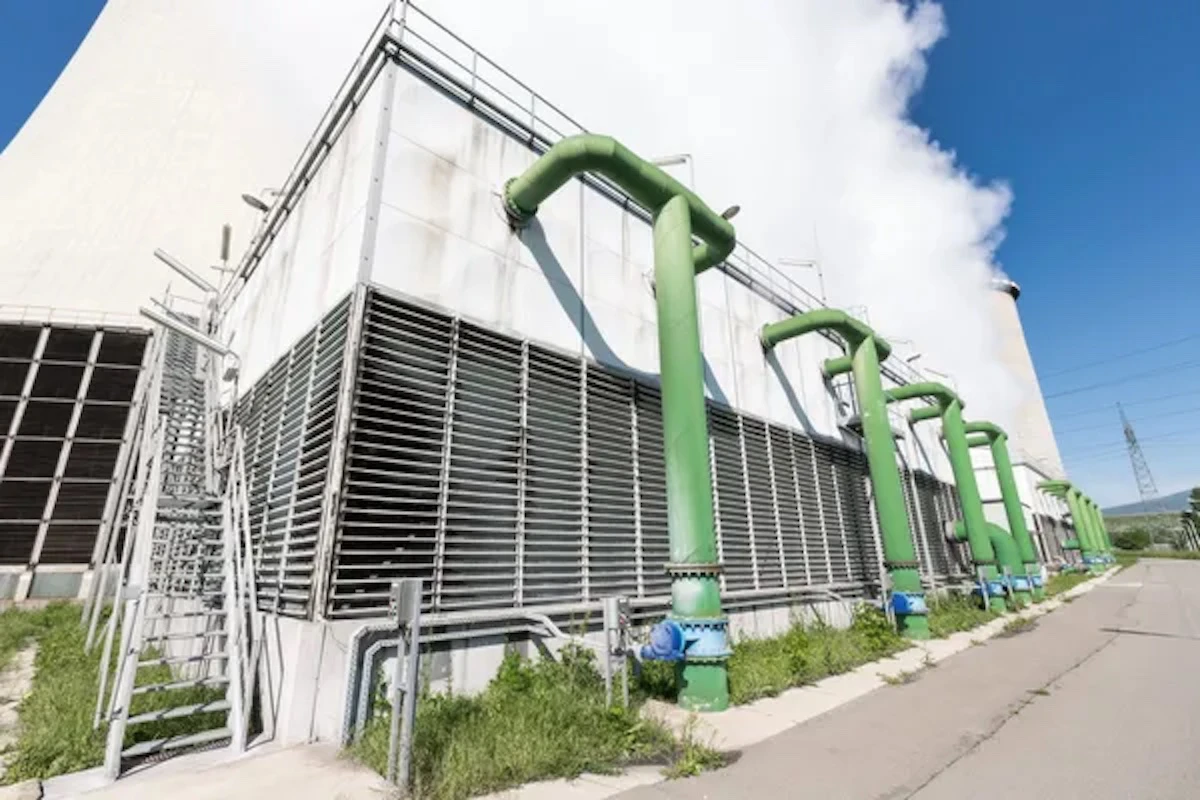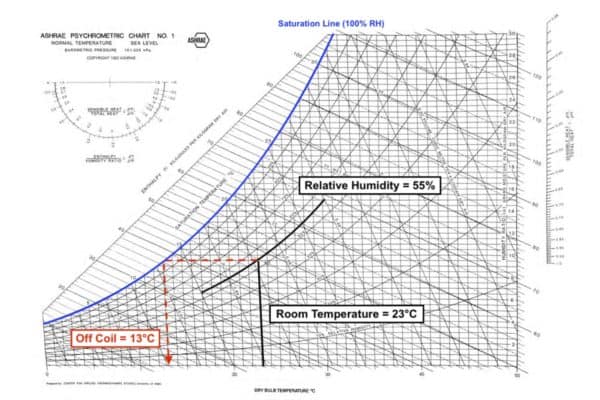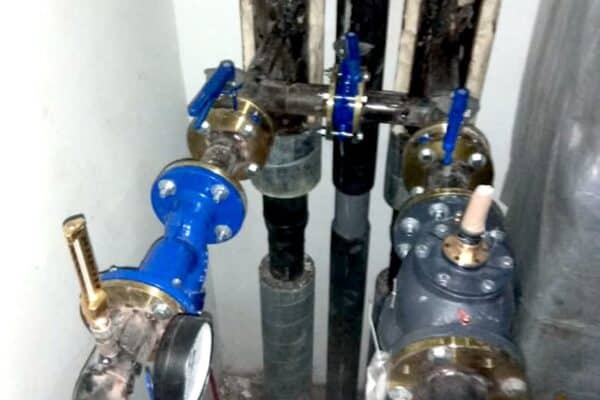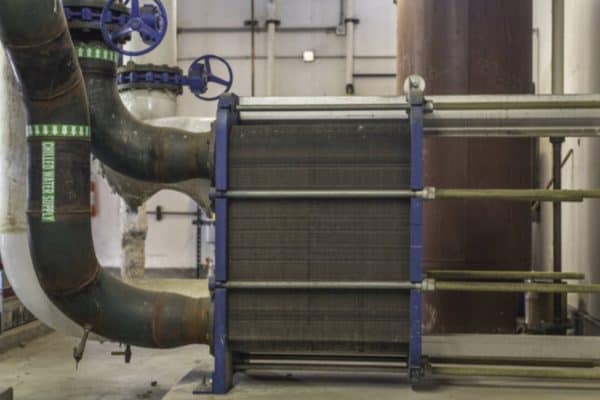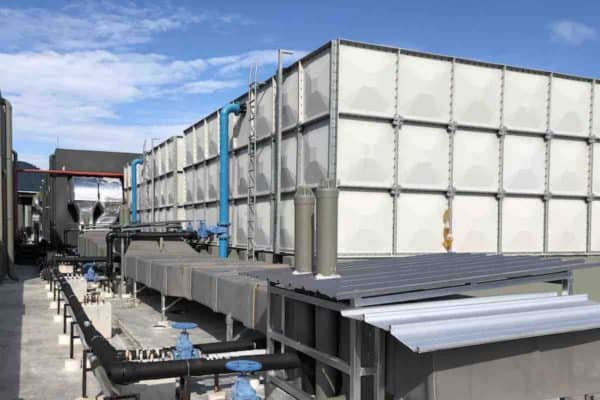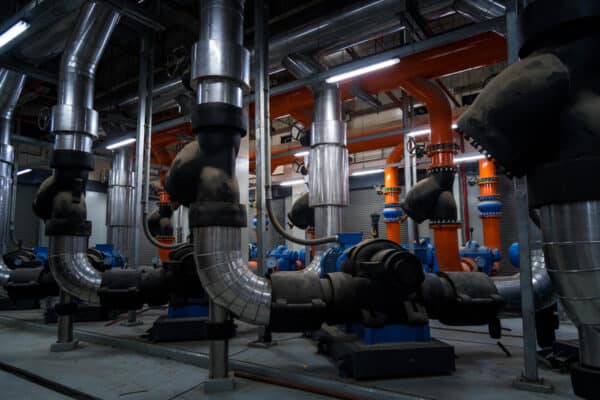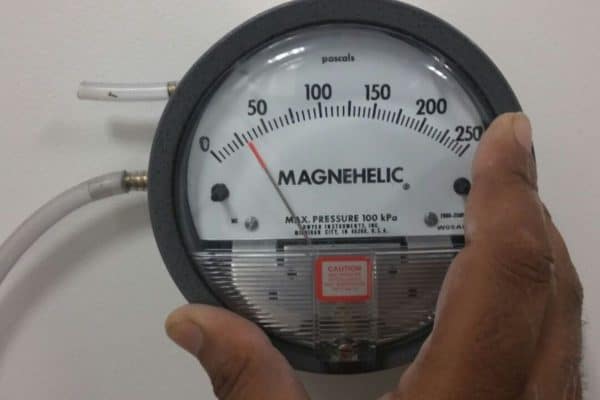Condenser Water Flow Rate Calculation (IP & SI)
One of the parameters to calculate when designing a chilled water system is the condenser water flow rate. Most of the time, it is estimated through the rule of thumb (gpm per ton). However, it can also be calculated by hand.
To calculate condenser water flow rate, determine the condenser water supply-return design temperature, the chiller capacity and efficiency first. Then, use the heat transfer formula (Q=mcθ) to calculate the required condenser water flow rate. The result is ft3/hr for IP unit and m3/s for SI unit.
The condenser water flow rate is calculated slightly differently from the chilled water flow rate. The heat transfer formula must include the power input of the chiller.
Condenser Water GPM per Ton
In a chilled water system, the flow rate “gpm per ton” is referring to how much water flow for every refrigeration tonnage (RT). The gpm stands for gallons per minute and it is based on the Imperial unit.
For SI unit, the flow rate is expressed in cubic meter per second (m3/s). However, litre per second (L/s) is more commonly used by the HVAC industry as it is easier to look at the numbers.
Now, a typical 600 RT chiller may have a condenser flow rate of 1848 gpm at full load. If we take the flow rate and divide it by the chiller capacity, we get:
1848 gpm ÷ 600 RT = 3.08 gpm per ton
Therefore, the standard value for condenser water flow rate is about 3.0 gpm per ton.
To get the chiller condenser flow rate, you normally have to get the chiller selected first. But, if you don’t, how can you calculate the required condenser water flow?
Condenser Water Flow Rate Calculation (IP)
When designing a new chilled water system, the condenser water flow rate has to be determined for pump selection. If the chiller is not yet selected, you can calculate the condenser water flow rate using the heat transfer formula.
Q = mcθ
where,
Q = chiller capacity, btu/hr
m = mass flow rate, lb/hr
c = specific heat of water, 1.0 btu/lb.°F
θ = condenser water temperature difference, °F
Since mass flow rate is the product of fluid density and volumetric flow rate (m=pq), the heat transfer formula can be rearranged as follows:
Q = pqcθ
where,
Q = chiller capacity, btu/hr
p = water density, 62.4 lb/ft3
q = condenser water flow rate, ft3/hr
c = specific heat of water, 1.0 btu/lb.°F
θ = condenser water temperature difference, °F
However, the condenser water not just carries the heat extracted from air conditioning spaces but also the heat produced by the chiller compressor and pump motor. So, the heat transfer formula must include the power input.
(Q+P) = pqcθ
where,
Q = chiller capacity, btu/hr
P = power input, btu/hr
p = water density, 62.4 lb/ft3
q = condenser water flow rate, ft3/hr
c = specific heat of water, 1.0 btu/lb.°F
θ = condenser water temperature difference, °F
Now, before we can calculate the condenser water flow rate, we must determine the chiller capacity, the condenser water supply-return design temperature and estimate the chiller efficiency.
A typical 600 RT water-cooled chiller has an energy efficiency of about 0.55 kW/Ton. Thus, the power input is estimated to be 330 kW. Multiply it by 3412 and we get the power input in btu/hr. Given that the standard condenser water design temperature is supply 86°F and return 95°F, the required condenser water flow rate can be calculated as follows:
(Q+P) = pqcθ
(600 x 12000) + (330 x 3412) = 62.4 x q x 1 x (95-86)
q = 8325960 ÷ 561.6
q = 14825.42 ft3/hr
Then, convert the condenser water flow rate from ft3/hr to gpm by dividing 14825.42 by 8.021 and we get a condenser water flow rate of 1848.32 gpm or 1848 gpm.
What we know from the calculation is that the standard 3.0 gpm per ton is based on a condenser water design temperature of supply 86°F and return 95°F, or anything that results in a delta T (ΔT) of 9°F, plus an estimated chiller efficiency of 0.55 kW/Ton.
kW/Ton is one of the four measurement units for chiller efficiency. Learn how to convert between these measurement units in my article: Chiller Efficiency Calculation: kW/Ton, COP, EER & IPLV/NPLV.
On a side note, if you want to quickly learn about chilled water system, you can get my Chilled Water System (eBook). If you’re into design, you can enroll in my Chilled Water System Design Course where I teach you various design procedures with tons of examples.
Chilled Water System Design Course
Learn how to design a chilled water system with AHU/FCU selection, chiller sizing, cooling tower sizing, pump sizing, piping design, ductwork design and more.
Condenser Water Flow Rate Calculation (SI)
When designing a new chilled water system, the condenser water flow rate has to be determined for pump selection. If the chiller is not yet selected, you can calculate the condenser water flow rate using the heat transfer formula.
Q = mcθ
where,
Q = chiller capacity, kW
m = mass flow rate, kg/s
c = specific heat of water, 4.187 kJ/kg.°C
θ = condenser water temperature difference, °C
Since mass flow rate is the product of fluid density and volumetric flow rate (m=pq), the heat transfer formula can be rearranged as follows:
Q = pqcθ
where,
Q = cooling capacity, kW
ρ = water density, 997 kg/m3
q = condenser water flow rate, m3/s
c = specific heat of water, 4.187 kJ/kg.°C
θ = condenser water temperature difference, °C
However, the condenser water not just carries the heat extracted from air conditioning spaces but also the heat produced by the chiller compressor, chilled water pump and condenser water pump. So, the heat transfer formula must include the power input.
(Q+P) = pqcθ
where,
Q = cooling capacity, kW
P = power input, kW
ρ = water density, 997 kg/m3
q = condenser water flow rate, m3/s
c = specific heat of water, 4.187 kJ/kg.°C
θ = condenser water temperature difference, °C
Now, before we can calculate the condenser water flow rate, we must determine the chiller capacity, the condenser water supply-return design temperature and estimate the chiller efficiency.
A typical 2110 kW water-cooled chiller has an energy efficiency of about 0.55 kW/Ton. Thus, the power input is estimated to be 330 kW. Given that the standard condenser water design temperature is supply 30°C and return 35°C, the required condenser water flow rate can be calculated as follows:
(Q+P) = pqcθ
(2110 + 330) = 997 x q x 4.187 x (35-30)
q = 2440 ÷ 20872.19
q = 0.1169 m3/s
Then, convert the condenser water flow rate from m3/s to L/s by multiplying 0.1169 by 1000 and we get a condenser water flow rate of 116.9 L/s or 117 L/s.
What we know from the calculation is that the standard 3.0 gpm per ton is based on the standard condenser water design temperature of supply 86°F (30°C) and return 95°F (35°C), or anything that results in a delta T of 9°F (5°C), plus an estimated chiller efficiency of 0.55 kW/Ton.
kW/Ton is one of the four measurement units for chiller efficiency. Learn how to convert between these measurement units in my article: Chiller Efficiency Calculation: kW/Ton, COP, EER & IPLV/NPLV.
To convert from IP to SI unit, use my HVAC Online Unit Converter.
Reduced Condenser Water Flow Rate
In my closely-related article Chilled Water Flow Rate Calculation (IP & SI), I mentioned that modern chilled water systems use a delta T of 15°F for chilled water. So, how about the condenser water?
The ASHRAE Green Guide suggested a condenser water delta T of between 12°F and 18°F. Meanwhile, one of the ASHRAE journals mentioned a condenser water delta T of 15°F.
At delta T 15°F, the condenser water flow rate is about 1.85 or 1.9 gpm per ton.
Similar to chilled water, a 33% of reduction in the condenser water flow will result in a 67% reduction in the condenser water pump power consumption. However, not all systems can realize that.
In order to achieve 15°F condenser water delta T, one possibility is to change the condenser water design temperature to supply 84°F and return 99°F.
It is more difficult to reduce the condenser water supply temperature (entering the chiller) because it is limited by the ambient wet-bulb temperature which is geographical-dependent. See How Cooling Towers Work.
On the other hand, the condenser water return temperature (leaving the chiller) is depending on the refrigerant temperature which depends on the capability of the chiller. With new types of refrigerant, it is possible to significantly increase the condenser water return temperature to reduce the flow and save pump energy.
Once again, you can get my Chilled Water System (eBook) to quickly learn more about chilled water system. But, if you want to learn how to design a chilled water system from start to end, I encourage you check out my Chilled Water System Design Course.
Chilled Water System Design Course
Learn how to design a chilled water system with AHU/FCU selection, chiller sizing, cooling tower sizing, pump sizing, piping design, ductwork design and more.
If you have anything to add (or ask) about this topic, leave a comment down below!


